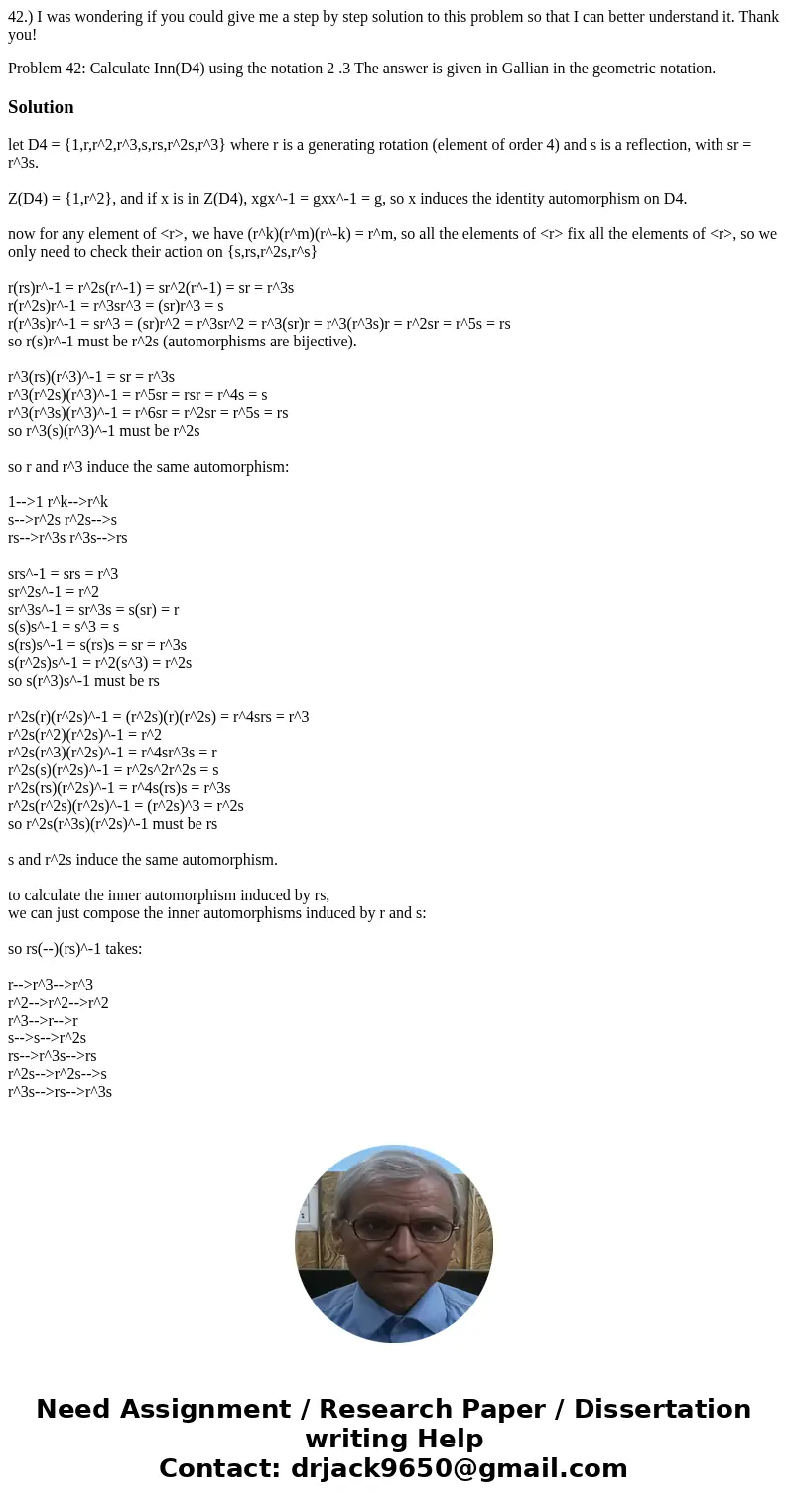42 I was wondering if you could give me a step by step solut
42.) I was wondering if you could give me a step by step solution to this problem so that I can better understand it. Thank you!
Problem 42: Calculate Inn(D4) using the notation 2 .3 The answer is given in Gallian in the geometric notation.Solution
let D4 = {1,r,r^2,r^3,s,rs,r^2s,r^3} where r is a generating rotation (element of order 4) and s is a reflection, with sr = r^3s.
Z(D4) = {1,r^2}, and if x is in Z(D4), xgx^-1 = gxx^-1 = g, so x induces the identity automorphism on D4.
now for any element of <r>, we have (r^k)(r^m)(r^-k) = r^m, so all the elements of <r> fix all the elements of <r>, so we only need to check their action on {s,rs,r^2s,r^s}
r(rs)r^-1 = r^2s(r^-1) = sr^2(r^-1) = sr = r^3s
r(r^2s)r^-1 = r^3sr^3 = (sr)r^3 = s
r(r^3s)r^-1 = sr^3 = (sr)r^2 = r^3sr^2 = r^3(sr)r = r^3(r^3s)r = r^2sr = r^5s = rs
so r(s)r^-1 must be r^2s (automorphisms are bijective).
r^3(rs)(r^3)^-1 = sr = r^3s
r^3(r^2s)(r^3)^-1 = r^5sr = rsr = r^4s = s
r^3(r^3s)(r^3)^-1 = r^6sr = r^2sr = r^5s = rs
so r^3(s)(r^3)^-1 must be r^2s
so r and r^3 induce the same automorphism:
1-->1 r^k-->r^k
s-->r^2s r^2s-->s
rs-->r^3s r^3s-->rs
srs^-1 = srs = r^3
sr^2s^-1 = r^2
sr^3s^-1 = sr^3s = s(sr) = r
s(s)s^-1 = s^3 = s
s(rs)s^-1 = s(rs)s = sr = r^3s
s(r^2s)s^-1 = r^2(s^3) = r^2s
so s(r^3)s^-1 must be rs
r^2s(r)(r^2s)^-1 = (r^2s)(r)(r^2s) = r^4srs = r^3
r^2s(r^2)(r^2s)^-1 = r^2
r^2s(r^3)(r^2s)^-1 = r^4sr^3s = r
r^2s(s)(r^2s)^-1 = r^2s^2r^2s = s
r^2s(rs)(r^2s)^-1 = r^4s(rs)s = r^3s
r^2s(r^2s)(r^2s)^-1 = (r^2s)^3 = r^2s
so r^2s(r^3s)(r^2s)^-1 must be rs
s and r^2s induce the same automorphism.
to calculate the inner automorphism induced by rs,
we can just compose the inner automorphisms induced by r and s:
so rs(--)(rs)^-1 takes:
r-->r^3-->r^3
r^2-->r^2-->r^2
r^3-->r-->r
s-->s-->r^2s
rs-->r^3s-->rs
r^2s-->r^2s-->s
r^3s-->rs-->r^3s
finally to calculate the inner automorphism induced by r^3s,
note that r and r^3 induce the same inner automorphism, so
r^3s induces the same inner automorphism as rs.
hence Inn(D4) has order 4. it is easy to see that each element
of Inn(D4) is its own inverse, so Inn(D4) is isomorphic to the Klein 4-group.

 Homework Sourse
Homework Sourse